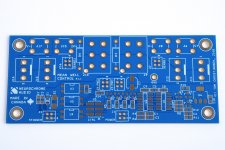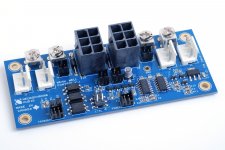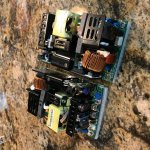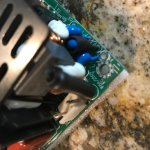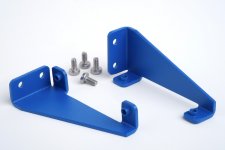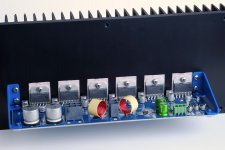Money isn't my primary concern, however I need to be honest, I've owned lots of amps the last couple of years and all of them were told to be among the best amp available.
Did they back it up with measurements?
I have to make a choise whether I buy a pair of suitable transformers (600 or 800VA) or go the Mean Well road.
A single 800 VA transformer is all you need for a stereo amp. If you want to go beyond that, have at it. Just beware that beyond 800 VA doesn't really buy you anything other than bulk and weight. Two 350-500 VA transformers (one per channel) would make for rather awesome mono blocks as well.
Is the Mean Well 400 Watt version (the one you recommend) suitable to deliver full power of the amp into 4 ohms?
The RPS-400-27-C provides enough power for short term sine wave operation at clipping levels into 4 Ω load with a stereo amp. That'll give you 130 W into 8 Ω and 200 W into 4 Ω. It provides enough power to power a stereo amp intended for music reproduction. It passes the 1974 FTC test (1/3 of the max rated output power for an hour into 4 Ω).
If you want to get the full 200+ W into 8 Ω, you'll need the RPS-400-36-C. I recommend using two per channel. That'll give you enough power for sine wave operation and long-term music operation.
Isn't a regulated PS less dynamic compared to a non-regulated one?
What does "dynamic" mean in this context and why would you want your power supply to be "dynamic"? I want my power supplies to be ideal voltage sources as that minimizes any impact they have on the amplifier performance. The switching supplies come closer to an ideal supply than any unregulated supply.
A bit more about my preferences, I don't like amps with lots of coloration. I do like valve amps a lot, but mainly for their amazing soundstage ability and posability to show micro details and "open" sound. However I don't like the coloration and I don't like the hassle with tubes.
A lot of the sound stage in valve amps comes from the harmonic distortion and inter-channel coupling (Haas effect). I would call that colouration.
So I am with you if you say an amp shouldn't color the sound, however it should show ALL the color what is in the input signal!
If that honestly is your goal, I think you'll be happy with the MOD686.
A few months back the sales manager for Wilson Benesch came to my house to demo some of their speakers and he heard my Neurochrome amps driving them. He was very impressed. They are also the UK distributors for CH Precision amps and they often use them at shows to demo their speakers. Those amps cost a shed load of money (as we say in these parts). That may not impress you, but it put a smile on my face. FWIW . . . .
That's awesome. Put a smile on my face too. 🙂
Tom
Last edited:
A single 800 VA transformer is all you need for a stereo amp. If you want to go beyond that, have at it. Just beware that beyond 800 VA doesn't really buy you anything other than bulk and weight. Two 350-500 VA transformers (one per channel) would make for rather awesome mono blocks as well.
The RPS-400-27-C provides enough power for short term sine wave operation at clipping levels into 4 Ω load with a stereo amp. That'll give you 130 W into 8 Ω and 200 W into 4 Ω. It provides enough power to power a stereo amp intended for music reproduction. It passes the 1974 FTC test (1/3 of the max rated output power for an hour into 4 Ω).
If you want to get the full 200+ W into 8 Ω, you'll need the RPS-400-36-C. I recommend using two per channel. That'll give you enough power for sine wave operation and long-term music operation.
I would like to have as high power as possible in 4 Ohms, as my LS are medium sensitive 4 Ohm LS. Is this possible with 1 Pcs. RPS-400-36 per channel? Or is the linear PS using 25VAC 500VA transformer the better choice for this?
What does "dynamic" mean in this context and why would you want your power supply to be "dynamic"? I want my power supplies to be ideal voltage sources as that minimizes any impact they have on the amplifier performance. The switching supplies come closer to an ideal supply than any unregulated supply.
Excuse me to be not completely clear, I don't want the PS to be dynamic… What I meant to say, isn't a non-regulated PS better suited to deliver fast big current swings?
Thanks,
Mark.
Excuse me to be not completely clear, I don't want the PS to be dynamic… What I meant to say, isn't a non-regulated PS better suited to deliver fast big current swings?
Mark,
Try checking posts 85 &87. I asked a very similar question a while back.
I would like to have as high power as possible in 4 Ohms, as my LS are medium sensitive 4 Ohm LS. Is this possible with 1 Pcs. RPS-400-36 per channel? Or is the linear PS using 25VAC 500VA transformer the better choice for this?
Well. You need to provide ±36 V (and 0.25-0.30 K/W heat sinks) if you want the full output power into 4 Ω. A single RPS-400-36 only provides +36 V, so it won't work at all. Any transformer+rectifier+caps would be better than a supply that doesn't work.
To get ±36 V (plus/minus thirty-six volt) you need two RPS-400-36 in series and a bit of control circuitry to tie them together nicely. That's why I made the Mean Well Control circuit.
What I meant to say, isn't a non-regulated PS better suited to deliver fast big current swings?
Depends. I provide the full explanation in Post #87. Also note that at higher frequencies, the majority of the energy is provided by the on-board caps due to the LC formed by the supply wiring harness and the on-board capacitors.
If you're curious about these things, I suggest setting up a simulation similar to what I did in my Taming the LM3886 - Supply Decoupling article. As a rough rule of thumb, figure 1 nH/mm of inductance for wire. You can get the wire resistance from the wire gauge. Include the ESR and ESL of the various caps. I bet you'll find that the supply only matters for the lower frequencies (< 1 kHz would be my guess) - well within the regulation bandwidth of the Mean Well switchers.
Mark,
Try checking posts 85 &87. I asked a very similar question a while back.
Excellent memory. Thank you!
Tom
Last edited:
I got that configuration running tonight. To compensate for the 6 dB gain difference between the MOD86 and MOD686, I dialled the gain of the tweeter channels up by 6 dB.
The MOD86+686 is a very capable amplifier combination on the LXmini. It doesn't sound quite as clean and coherent as I remember the 4xMOD686, but it's also considerably lower cost. In addition, the MOD686 does contain a few new tricks, which drive up the performance even further and could explain some of the difference.
That said, the MOD86+686 does offer an improvement over the 4xMOD86. For example, I find the bass to be much better controlled by the MOD686, in particular at higher settings on the volume control. Also the harshness I perceived at higher volume settings with the 4xMOD86 is now gone. Maybe you really do need more than 40 W. 😱
I'll still recommend 4xMOD86 for those who are on a limited budget or who prefer to build using leaded components only. Those who are looking for even higher performance should consider the MOD86-686 or 4xMOD686 for their LXmini.
Tom
So if you put a Mod-86/mod-686 together in a 330x300x3U enclosure I assume we could use the Power 686 and a transformer to power both? Would a 400VA x22V work or would a different voltage output be better?
So if you put a Mod-86/mod-686 together in a 330x300x3U enclosure I assume we could use the Power 686 and a transformer to power both? Would a 400VA x22V work or would a different voltage output be better?
If you're designing specifically for the LXmini (4Ω tweeter, 8Ω woofer), a 3U chassis and ±27-28 V supply would work. A Power-686 and 2x22 VAC @ 400 VA would be the right size for music reproduction. It would be a tight squeeze to shoehorn all that into a 3U x 330 x 300 Mini Dissipante, but it might be possible.
An alternative would be the Mean Well RPS-400-27-C. Again, it'll be a tight squeeze - especially due to the width of the Modulus-86 boards, but it could be possible. It certainly will be possible with the Modulus-186 (planned for release around mid-November) as it'll be the same 2.3" width as the MOD686.
The MOD186 will be the same performance as the MOD86 but in all SMD. Same deal as with the MOD686: SMD pre-populated and fully assembled options only. I know some will squirm because of this, but I can deliver a better and more consistent product at a lower price by dropping the bare board option. Better performance. Lower price. What's not to like? 🙂
Tom
....
The MOD186 will be the same performance as the MOD86 but in all SMD. Same deal as with the MOD686: SMD pre-populated and fully assembled options only. I know some will squirm because of this, but I can deliver a better and more consistent product at a lower price by dropping the bare board option. Better performance. Lower price. What's not to like? 🙂
Tom
Sign me up 😉
Best,
Anand
Sign me up 😉
You got it! If you subscribe to my newsletter, you'll be the first to know. You can sign up here: Sign Up to Stay Informed
Should you wish for more day-to-day updates, you can follow Neurochrome on Facebook (or here).
Tom
Those of you who are looking to use the Mean Well RPS- or EPP-series switching supplies with your amplifiers may be interested in my latest: Mean Well Control. I've wrapped up the last loose ends in the design, received the first stack of boards, and will be filling the pre-orders this weekend.
The MW Control handles all the connections between two Mean Well RPS/EPP 300/400 series supplies and the Neurochrome Modulus amps, including the MOD686.
More information on the Mean Well Control is available on my website: Mean Well RPS/EPP-series SMPS controller for use in audio amplifiers.
Tom
The MW Control handles all the connections between two Mean Well RPS/EPP 300/400 series supplies and the Neurochrome Modulus amps, including the MOD686.
More information on the Mean Well Control is available on my website: Mean Well RPS/EPP-series SMPS controller for use in audio amplifiers.
Tom
Attachments
If I was to pop the top off the 686 currently on rotating loan here, would I be finding one of those inside?
If I was to pop the top off the 686 currently on rotating loan here, would I be finding one of those inside?
Yep. You'd find Rev. 1.0 of the Mean Well Control in there. You can even see it on the build pictures in Post 601.
Tom
Started Mod686 Build
Just received all the parts for the 686 main boards and two Meanwell RPS-400-36 SMPS's, PCB mount version. They sure do cram quite a bit of circuitry in a small space. According to a Meanwell product support person, there are actually 2 fuses on the board. I could only locate the 8A fuse by the mains input. Consequently, I am not planning on using an IEC outlet with a fuse. It looks like the user could replace the leaded main fuse if required, although it would take some work.
Steve
Just received all the parts for the 686 main boards and two Meanwell RPS-400-36 SMPS's, PCB mount version. They sure do cram quite a bit of circuitry in a small space. According to a Meanwell product support person, there are actually 2 fuses on the board. I could only locate the 8A fuse by the mains input. Consequently, I am not planning on using an IEC outlet with a fuse. It looks like the user could replace the leaded main fuse if required, although it would take some work.
Steve
Attachments
Yeah. The Mean Wells are fused. I still put a 10 A slow-blow fuse in the IEC inlet just in case the wiring from the IEC inlet to the supplies short to the chassis. The odds of this are obviously extremely low, but the fuse doesn't cost much and makes me sleep better at night.
I agree that the component density on those modules is pretty amazing. They're densely packed for sure.
Tom
I agree that the component density on those modules is pretty amazing. They're densely packed for sure.
Tom
Just received all the parts for the 686 main boards and two Meanwell RPS-400-36 SMPS's, PCB mount version. They sure do cram quite a bit of circuitry in a small space. According to a Meanwell product support person, there are actually 2 fuses on the board. I could only locate the 8A fuse by the mains input. Consequently, I am not planning on using an IEC outlet with a fuse. It looks like the user could replace the leaded main fuse if required, although it would take some work.
Steve
Are you planning to power two modulus 686 boards with only two RPS-400-36 supplies? I thought you needed four of those, or am i mistaken here?
daansan:
I plan on using one PS per channel rather than two. This is based upon my pre-order questions from Tom. Here is his response. Tom, please chime in if this doesn't cover it:
"One note: To get the full output power, you need ±36 V, however, the RPS-400-36 does technically not provide enough current to power a stereo amp. It probably doesn’t matter in practice, but if you ever perform sine wave testing of the amp, the supplies will turn off when they hit the current limit. That’s no biggie. Just unplug the power cord, wait 30 seconds, and plug it back in. With music signal, I’m less concerned, especially if you run the channels out of phase (i.e. swap pin 2 and 3 on the input and swap the two output connections on one of the channels).
If you want the full output power available even with sine wave testing, I suggest using a pair of RPS-400-36 per channel (so four supplies total for a stereo amp).
Alternatively, you can use a pair of RPS-400-27 to power your stereo amp. You’ll get 130 W into 8 Ω and 200 W into 4 Ω."
For my system, I have efficient speakers (93 dB) and lots of source voltage (6V) so I am not concerned about achieving the full power output as advertised .
Steve
I plan on using one PS per channel rather than two. This is based upon my pre-order questions from Tom. Here is his response. Tom, please chime in if this doesn't cover it:
"One note: To get the full output power, you need ±36 V, however, the RPS-400-36 does technically not provide enough current to power a stereo amp. It probably doesn’t matter in practice, but if you ever perform sine wave testing of the amp, the supplies will turn off when they hit the current limit. That’s no biggie. Just unplug the power cord, wait 30 seconds, and plug it back in. With music signal, I’m less concerned, especially if you run the channels out of phase (i.e. swap pin 2 and 3 on the input and swap the two output connections on one of the channels).
If you want the full output power available even with sine wave testing, I suggest using a pair of RPS-400-36 per channel (so four supplies total for a stereo amp).
Alternatively, you can use a pair of RPS-400-27 to power your stereo amp. You’ll get 130 W into 8 Ω and 200 W into 4 Ω."
For my system, I have efficient speakers (93 dB) and lots of source voltage (6V) so I am not concerned about achieving the full power output as advertised .
Steve
I should have said "I am not concerned about achieving the power required for my desired listening levels".
Steve
Steve
So to add precision: The RPS-400-36 delivers about 11 A of continuous output current. The current limiter kicks in around 14-15 A (peak) under sine wave testing, so the RPS-400-36 is technically slightly under-powered for the Modulus-686 (assuming a 4 Ω load). It'll work fine with music where the average current is considerably lower than the peak currents, which is why I am comfortable recommending one pair of RPS-400-36 per channel.
Pushing this to two channels of MOD686 on one pair of RPS-400-36 is guaranteed to make the amp fail sine wave testing and very likely also my usual "music" (32-tone AP test signal) test with both channels running at clipping levels with a 4 Ω load. The current limiter in the supply will kick in. Guaranteed! As noted above, that's not a big deal (i.e. won't catastrophically destroy the amp) but is obviously not a robust design, which is why I generally don't recommend doing that.
That said, this is DIY and I'm not planning to start knocking on people's doors to inspect the amps they've built to make sure that everybody follows my recommendations. It would be pretty cool to meet everybody, but I don't quite have that kind of travel budget. Nor do I think it would be reasonable behaviour, but that's another issue. 🙂
Anyway. With this being DIY, if someone is confident that they don't need the full power of the MOD686 for any significant length of time, but would like to have the headroom available for very brief peaks near the full output power, one option that they can entertain is to use one pair of RPS-400-36 to power a stereo Modulus-686 amp. It's not something I would recommend for everybody, but it is certainly one way to go. After all, this is DIY.
If you want the Modulus-686 to drive a 4 Ω load to clipping, my recommendations remain:
2 x RPS-400-27-C powering 2 x MOD686 for 130 W (8 Ω); 200 W (4 Ω) per channel.
...or...
2 x RPS-400-36-C powering 1 x MOD686 for 240 W (8 Ω); 360 W (4 Ω) in mono.
For 8 Ω loads, you can have one pair of RPS-400-36-C powering a stereo MOD686 as well. You'll get 230 W into 8 Ω but won't be able to drive a 4 Ω load to clipping.
The -C indicates the caged version of the RPS-400 supply. The cage keeps fingers away from high-voltage nodes and if you follow Mean Well's mounting instructions (see the RPS-400 data sheet), the cage will also ensure that all the safety distances (creepage) are met.
My recommendations are intended to ensure that my builders end up with a robust amp that will meet the published specs and handle whatever you throw at it (within its published limits). Whether you follow my recommendations is really up to you.
I hope this clarifies things a bit. Tradeoffs, tradeoffs... 🙂
Tom
Pushing this to two channels of MOD686 on one pair of RPS-400-36 is guaranteed to make the amp fail sine wave testing and very likely also my usual "music" (32-tone AP test signal) test with both channels running at clipping levels with a 4 Ω load. The current limiter in the supply will kick in. Guaranteed! As noted above, that's not a big deal (i.e. won't catastrophically destroy the amp) but is obviously not a robust design, which is why I generally don't recommend doing that.
That said, this is DIY and I'm not planning to start knocking on people's doors to inspect the amps they've built to make sure that everybody follows my recommendations. It would be pretty cool to meet everybody, but I don't quite have that kind of travel budget. Nor do I think it would be reasonable behaviour, but that's another issue. 🙂
Anyway. With this being DIY, if someone is confident that they don't need the full power of the MOD686 for any significant length of time, but would like to have the headroom available for very brief peaks near the full output power, one option that they can entertain is to use one pair of RPS-400-36 to power a stereo Modulus-686 amp. It's not something I would recommend for everybody, but it is certainly one way to go. After all, this is DIY.
If you want the Modulus-686 to drive a 4 Ω load to clipping, my recommendations remain:
2 x RPS-400-27-C powering 2 x MOD686 for 130 W (8 Ω); 200 W (4 Ω) per channel.
...or...
2 x RPS-400-36-C powering 1 x MOD686 for 240 W (8 Ω); 360 W (4 Ω) in mono.
For 8 Ω loads, you can have one pair of RPS-400-36-C powering a stereo MOD686 as well. You'll get 230 W into 8 Ω but won't be able to drive a 4 Ω load to clipping.
The -C indicates the caged version of the RPS-400 supply. The cage keeps fingers away from high-voltage nodes and if you follow Mean Well's mounting instructions (see the RPS-400 data sheet), the cage will also ensure that all the safety distances (creepage) are met.
My recommendations are intended to ensure that my builders end up with a robust amp that will meet the published specs and handle whatever you throw at it (within its published limits). Whether you follow my recommendations is really up to you.
I hope this clarifies things a bit. Tradeoffs, tradeoffs... 🙂
Tom
Tom,
Thanks for putting together an informative post on MOD686 power supply requirements using SMPS options.
Thanks for putting together an informative post on MOD686 power supply requirements using SMPS options.
A while back I mentioned that I was planning to offer a less expensive mounting bracket for the Modulus-686. Please welcome the Modulus Bracket. It'll fit the Modulus-686 (and Modulus-286 Rev. 2.0 and Modulus-186 when they become available).
The new brackets are almost 40 % lower cost. Unfortunately, reality is that custom metalwork is still expensive, so the brackets are $25 per set. One set will hold one board to the heat sink. The set is delivered with the four M3 machine screws necessary to hold the board to the bracket. You're on your own for the screws that hold the brackets and LM3886es to the heat sink. The mounting holes in the brackets are 130 mil in diameter (3.3 mm), thus will fit M3 and US #4 screws.
As always, I started with a small batch of brackets, so I'm out of stock already. I'll have more in stock in about two weeks. You can preorder through my website. The bracket set is one of the options on the Modulus-686 product page. If you don't see this option, please hit reload in your browser.
Tom
The new brackets are almost 40 % lower cost. Unfortunately, reality is that custom metalwork is still expensive, so the brackets are $25 per set. One set will hold one board to the heat sink. The set is delivered with the four M3 machine screws necessary to hold the board to the bracket. You're on your own for the screws that hold the brackets and LM3886es to the heat sink. The mounting holes in the brackets are 130 mil in diameter (3.3 mm), thus will fit M3 and US #4 screws.
As always, I started with a small batch of brackets, so I'm out of stock already. I'll have more in stock in about two weeks. You can preorder through my website. The bracket set is one of the options on the Modulus-686 product page. If you don't see this option, please hit reload in your browser.
Tom
Attachments
- Home
- Vendor's Bazaar
- Modulus-686: 380W (4Ω); 220W (8Ω) Balanced Composite Power Amp with extremely low THD
